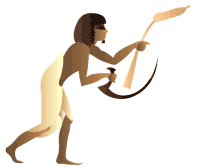Developed independently by geographically distant populations, systematic agriculture first appeared in Southwest Asia with the bulk of domesticated neolthic crops and livestock now being traced to Turkey via DNA studies. The first grains of domesticated Turkish emmer wheat are found at Abu Hurerya dated to 13,500 BP. The only exceptions to this are barley, domesticated in two sites; in Israel, and East of the Zagros mountains in Iran. The eight so-called founder crops of agriculture appear: first emmer and einkorn wheat, then hulled barley, peas, lentils, bitter vetch, chick peas and flax. Bitter vetch and lentils along with almonds and pistachios appear in Franchthi Cave Greece simultaneously, about 9,000 BC. Neither are native to Greece, and they appear 2,000 years prior to domesticated wheat in the same location. This suggests that the cultivation of legumes and nuts preceded that of grain.

|
By 5000 BCE, the Sumerians had developed core agricultural techniques including large scale intensive cultivation of land, mono-cropping, organized irrigation, and use of a specialized labour force, particularly along the waterway now known as the Shatt al-Arab, from its Persian Gulf delta to the confluence of the Tigris and Euphrates. Domestication of wild aurochs and mouflon into cattle and sheep, respectively, ushered in the large-scale use of animals for food/fiber and as beasts of burden. The shepherd joined the farmer as an essential provider for sedentary and semi-nomadic societies.
Maize, manioc, and arrowroot were first domesticated in the Americas as far back as 5200 BCE. The potato, tomato, pepper, squash, several varieties of bean, Canna, tobacco and several other plants were also developed in the New World, as was extensive terracing of steep hillsides in much of Andean South America.
In later years, the Greeks and Romans built on techniques pioneered by the Sumerians but made few fundamentally new advances. Southern Greeks struggled with very poor soils, yet managed to become a dominant society for years. The Romans were noted for an emphasis on the cultivation of crops for trade.
Excerpted and adapted from: Agriculture